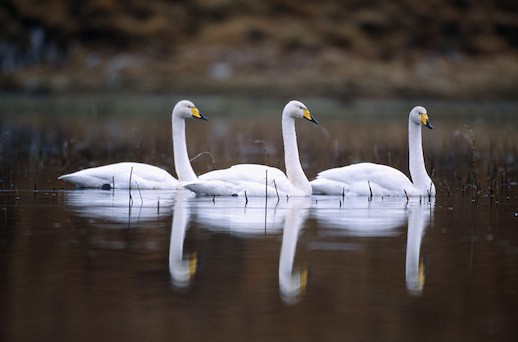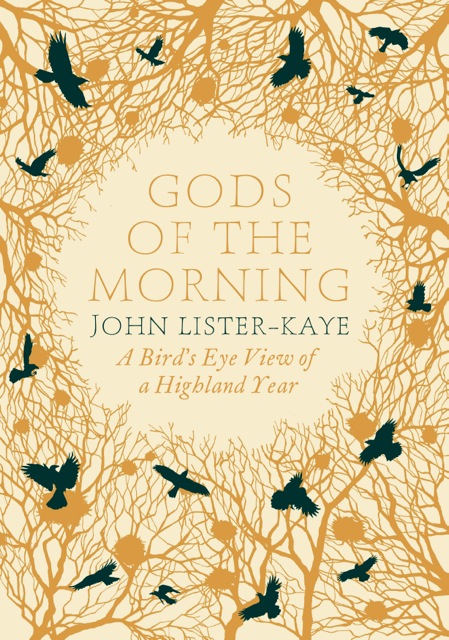Our guest columnist this month is the author and naturalist John Lister-Kaye.
Winter has begun to depart:
Sometimes it’s March, sometimes a bit later in April. This year – such a topsy-turvy, on-off winter that even now doesn’t seem to want to end – they kept me guessing. But it didn’t stop me listening.
On a winter expedition to Lapland many years ago, I happened across a whooper swan breeding ground far north of the Arctic Circle. It was a frozen bog, as silent and rigid as a Christmas card, but extravagantly beautiful with high, snow-covered nest mounds dotted about among acres of frozen lagoons of moss and sedges systematically repeating like relief patterns on a vast counterpane of icy crêpe de chine. I meandered from nest to nest in a trance. In one I even found an addled egg, marble cold and nearly as heavy. As it lay in my mittened hand I imagined the summer: dozens of these exquisite yellow-billed swans and their fluffy cygnets dabbling in the safety of the boggy shallows, necks stained ochre by the ooze from which they grubbled the rich animal and vegetable vichyssoise that grows the cygnets quickly through the short summer. It was an image that stayed.
About ten whoopers over-winter in our Highland glen. Some years it’s more, some less. They always come, arriving in the night, just in from Iceland, in small family groups, sometimes two or three together, adults and grey necked cygnets flying in a broad chevron to pitch on the river or our little hill loch up on the moor. They stay with us until the frosts become too hard, when they move back to the estuaries and the foreshore.
The first I know of it is their bugling calls echoing out of the darkness as they pass. I rush to the window to catch the flash of moonlight on broad silver wings. Then they become part of our winter, with us every day so that we expect the summons of their wild voices. In spring they vanish in the night – one minute there they are, standing about on the river fields, gathering in large flocks whiter than surf; long, straight necks like yellow-handled walking sticks, all softly fluting to themselves. Then they are gone.
These are wild swans, quite different from the posed, voluptuous ogees of mute swans of parks, reservoirs and calendars; these whoopers are a distillation of wildness, finer, purer and then – suddenly gone, tugged away by the stars and the lengthening days. They have lifted off into the northern night in undulating skeins. During the long green summer we forget them, put them out of mind to concentrate on some of the incomers yet to arrive: ospreys, wheatears and swallows.
But on their return to the valley each October, bugling their blood-tingling voices across the night sky, they herald one of the most stirring moments of the incipient Highland winter. They seem to be dragging winter with them from the far north. And now, because they will depart any day now, back to those high Arctic breeding grounds, I seem to have been listening out for them for weeks.
When it happened a few nights ago, I was in bed and asleep – well, half asleep – I always seem to have one ear cocked to the wide-open window beside me. I was out of bed in a flash. They circled the house in a broad arc not far above the trees, although I could see nothing; just this haunting, primordial utterance of the night, which, for me, together with the howl of the wolf and the fluting of common cranes seems to define boreal wildness – one of the most evocative sounds I know. I knew from their altitude that they were heading for the loch, so in the morning I checked them out. There they were, six adults and five strong cygnets from last year, busy sifting through the marsh. As I appeared their heads shot up like railway signals and they whooped their little nasal anxieties to each other, nervous and fidgety. I watched quietly for a few minutes and then shrank back into the birches, leaving them in peace.
They won’t stay long now. Our loch is a resting place where they wait for the wind to shift into their favour, or perhaps for an anti-cyclone of calming high pressure, or perhaps until their hear the flutings of other whoopers passing overhead. I don’t know, but I do know that to have them drop by is a joy. It’s one of the year’s moments I look forward to and a chance to bid them bon voyage. I get possessive – my whoopers – and I watch out for them every day, listen out every night.
So March is a passing thought, and at last we have daffodils. The pinkfooted geese and greylags are still with us in large flocks on the Beauly Firth, and the sky is criss-crossed with their wavering haggling skeins as they move from feeding ground to mudflats and back again. Sometimes they leave before the whoopers, sometimes later. There doesn’t seem to be a plan. Yesterday I spent the day ducking sleet squalls on the sea wall trying to work out just what was going on. No chance. Thousands of wigeon and loads of teal – they’ll be off soon too, but the movements of the geese and the few whoopers I could find were as random and confusing as usual. I came home and nipped up to the loch. There they were, still sifting and dabbling in the marsh as though the idea of migration had never occurred to them. ‘Oh well,’ I thought, ‘they’re moment will come,’ and strode back to the house to get warm.
Then, last night, at exactly 2.00am, I heard them. I was out of bed in a flash, craning my neck at the open window. They had lifted from the loch in a thin bright line and were gaining height, calling loudly as they rose. They circled once over the black spears of the forest, then again, right towards me, over the house, moonlight gleaming with the patina of old silver on their backs and their flutings filling the chill night air. Then they were gone. I lingered, just to see if they would circle again, but that was it. I knew I wouldn’t see them again until late October. ‘What was it?’ my wife Lucy had asked me drowsily when I climbed back into bed. ‘It’s winter,’ I said. ‘Winter’s just departed.’
Sir John’s latest book, God’s Of The Morning: A Bird’s Eye View of a Highland Year, was published by Canongate in March. Read Neil Ansell’s review for Caught by the River here and pick up a copy directly from the author, here.

